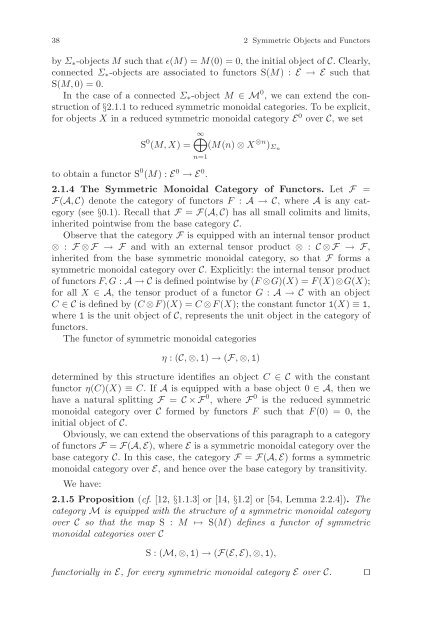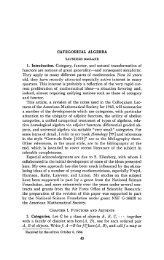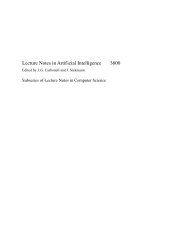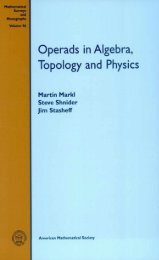Symmetric Monoidal Categories for Operads - Index of
Symmetric Monoidal Categories for Operads - Index of
Symmetric Monoidal Categories for Operads - Index of
You also want an ePaper? Increase the reach of your titles
YUMPU automatically turns print PDFs into web optimized ePapers that Google loves.
38 2 <strong>Symmetric</strong> Objects and Functors<br />
by Σ∗-objects M such that ɛ(M) =M(0) = 0, the initial object <strong>of</strong> C. Clearly,<br />
connected Σ∗-objects are associated to functors S(M) :E → E such that<br />
S(M,0) = 0.<br />
In the case <strong>of</strong> a connected Σ∗-object M ∈M 0 , we can extend the construction<br />
<strong>of</strong> §2.1.1 to reduced symmetric monoidal categories. To be explicit,<br />
<strong>for</strong> objects X in a reduced symmetric monoidal category E 0 over C, weset<br />
S 0 (M,X) =<br />
∞�<br />
n=1<br />
to obtain a functor S 0 (M) :E 0 →E 0 .<br />
(M(n) ⊗ X ⊗n )Σn<br />
2.1.4 The <strong>Symmetric</strong> <strong>Monoidal</strong> Category <strong>of</strong> Functors. Let F =<br />
F(A, C) denote the category <strong>of</strong> functors F : A→C,whereA is any category<br />
(see §0.1). Recall that F = F(A, C) has all small colimits and limits,<br />
inherited pointwise from the base category C.<br />
Observe that the category F is equipped with an internal tensor product<br />
⊗ : F⊗F → F and with an external tensor product ⊗ : C⊗F → F,<br />
inherited from the base symmetric monoidal category, so that F <strong>for</strong>ms a<br />
symmetric monoidal category over C. Explicitly: the internal tensor product<br />
<strong>of</strong> functors F, G : A→Cis defined pointwise by (F ⊗G)(X) =F (X)⊗G(X);<br />
<strong>for</strong> all X ∈A, the tensor product <strong>of</strong> a functor G : A→Cwith an object<br />
C ∈Cis defined by (C ⊗ F )(X) =C ⊗ F (X); the constant functor 1(X) ≡ 1,<br />
where 1 is the unit object <strong>of</strong> C, represents the unit object in the category <strong>of</strong><br />
functors.<br />
The functor <strong>of</strong> symmetric monoidal categories<br />
η :(C, ⊗, 1) → (F, ⊗, 1)<br />
determined by this structure identifies an object C ∈Cwith the constant<br />
functor η(C)(X) ≡ C. IfA is equipped with a base object 0 ∈A,thenwe<br />
have a natural splitting F = C×F 0 ,whereF 0 is the reduced symmetric<br />
monoidal category over C <strong>for</strong>med by functors F such that F (0) = 0, the<br />
initial object <strong>of</strong> C.<br />
Obviously, we can extend the observations <strong>of</strong> this paragraph to a category<br />
<strong>of</strong> functors F = F(A, E), where E is a symmetric monoidal category over the<br />
base category C. In this case, the category F = F(A, E) <strong>for</strong>ms a symmetric<br />
monoidal category over E, and hence over the base category by transitivity.<br />
We have:<br />
2.1.5 Proposition (cf. [12,§1.1.3] or [14, §1.2] or [54, Lemma 2.2.4]). The<br />
category M is equipped with the structure <strong>of</strong> a symmetric monoidal category<br />
over C so that the map S : M ↦→ S(M) defines a functor <strong>of</strong> symmetric<br />
monoidal categories over C<br />
S:(M, ⊗, 1) → (F(E, E), ⊗, 1),<br />
functorially in E, <strong>for</strong> every symmetric monoidal category E over C. ⊓⊔






